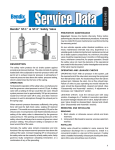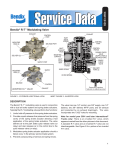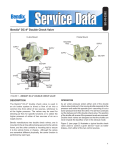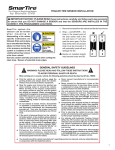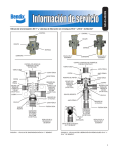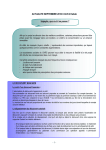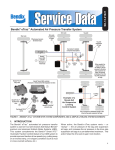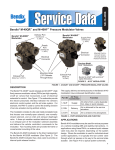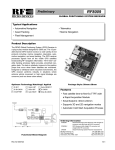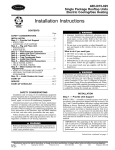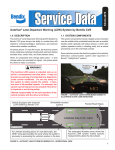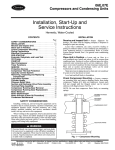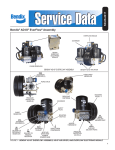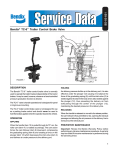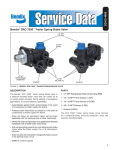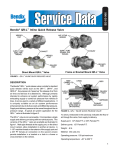Download BENDIX SD-03-1901 User's Manual
Transcript
SD-03-1901 ® Bendix® ST-1™ & ST-3™ Safety Valve Normally, the safety valve remains inoperative and only functions if for any reason reservoir pressure rises above the setting of the valve. Constant “popping off” or exhausting of the safety valve can be caused by a faulty safety valve, faulty governor, faulty compressor unloading mechanism, or a combination of any of the preceding. EXHAUST PORT PRESSURE SETTING 150 PSI BENDIX® ST-1™ VALVE PREVENTIVE MAINTENANCE BENDIX® ST-3™ VALVE DESCRIPTION The safety valve protects the air brake system against excessive air pressure build‑up. The valve consists of a spring-loaded ball valve subjected to reservoir pressure which will permit air to exhaust reservoir pressure to atmosphere, if the reservoir pressure rises above the valves pressure setting. This pressure is determined by the force of the spring. OPERATION To illustrate the operation of the safety valve, we shall assume that the governor cut-out pressure is set at 125 psi. A safety valve with a setting of 150 psi could then be used. Should system pressure rise to approximately 150 psi air pressure would force the ball valve off its seat, and allow reservoir pressure to vent to atmosphere through the exhaust port in the spring cage. When reservoir pressure decreases sufficiently, the spring force will seat the ball check valve, sealing off reservoir pressure. This would occur at approximately 135 psi for the 150 psi valve. It is important to note that the desired pressure setting of the safety valve is determined by the governor cut-out pressure. The opening and closing pressures of the safety valve should always be in excess of governor cut-out pressure setting. The pressure setting is stamped on the lower wrench flat of the valve. Important: Review the Bendix Warranty Policy before performing any intrusive maintenance procedures. A warranty may be voided if intrusive maintenance is performed during the warranty period. No two vehicles operate under identical conditions, as a result, maintenance intervals may vary. Experience is a valuable guide in determining the best maintenance interval for air brake system components. At a minimum, the safety valve should be inspected every 6 months or 1500 operating hours, whichever comes first, for proper operation. Should the safety valve not meet the elements of the operational tests noted in this document, further investigation and service of the valve may be required. OPERATING AND LEAKAGE CHECKS OPERATING TEST: With air pressure in the system, pull the exposed end of the valve stem removing the spring load from the ball check valve. Air should exhaust from the valve’s exhaust port. Release the stem, the air flow should stop. Failure of valve to pass operating test would indicate the valve should be disassembled, cleaned and rebuilt. (See “Disassembly and Assembly” section). If adjustment is necessary, see “Adjustment” section. LEAKAGE CHECK: Coat the exhaust port with soap solution. A leakage of a one (1) inch bubble in 5 seconds is permitted. Excessive leakage indicates dirt in valve, faulty ball valve or seat. Valve should be disassembled, cleaned and rebuilt. (See “Disassembly and Assembly” section). 1 REMOVAL AND INSTALLATION REMOVAL 1. Block the wheels or otherwise secure the vehicle and drain the reservoirs. 2. Using the wrench flat closest to reservoir, unscrew valve from reservoir. INSTALLATION The safety valve should be installed in the same reservoir that the compressor discharge line is connected to. Install the valve in a convenient location in a top port of the reservoir. If the safety valve is installed horizontally the exhaust port should point down and the stem of the valve should face the rear of the vehicle. DISASSEMBLY: BENDIX® ST‑1™ ADJUSTABLE VALVE 1. Clamp the lower wrench flat in a vise (flat nearest the pipe thread). 2. Using the upper wrench flat, unscrew the locknut. Unscrew and remove the spring cage from body of valve. 3. Remove the ball valve, spring and the release pin from the spring cage. DISASSEMBLY: BENDIX® ST‑3™ NON‑ADJUSTABLE VALVE 1. Clamp the spring cage in soft jawed vise. 2. Using the wrench flat, unscrew the body from spring cage. 3. Remove the ball valve, spring and release pin from spring cage. CLEANING AND INSPECTION Clean all parts in mineral spirits. Inspect all parts thoroughly. All parts not considered serviceable should be replaced with genuine Bendix replacement parts. ASSEMBLY: ST‑1 ADJUSTABLE VALVE 1. Place the ball valve in the body. 2. Install the spring and release pin in the spring cage with the adjusting screw. 3. Position the release pin over the ball valve. Screw the body with the ball into the spring cage. Tighten securely. 4. Adjust for proper setting (see the “Adjustment” section). ASSEMBLY: ST‑3 NON‑ADJUSTABLE VALVE 1. Install the spring and release pin in the spring cage. 2. Position the ball valve in the body and screw the spring cage onto the body. 3. Hold the spring cage in a soft jawed vise and tighten the body securely. 2 RELEASE PIN ADJUSTING NUT LOCKNUT SPRING CAGE SPRING BENDIX® ST-1™ SAFETY VALVE BALL VALVE BODY PIPE THREAD RELEASE PIN SPRING CAGE SPRING BALL VALVE BODY PIPE THREAD BENDIX® ST-3™ SAFETY VALVE TO RAISE THE PRESSURE SETTING 1. Loosen the locknut. 2. Turn the adjusting nut clockwise to obtain the correct pressure setting. 3. Tighten the locknut. TO LOWER THE PRESSURE SETTING 1. Loosen the locknut. 2. Turn the adjusting nut counter clockwise to obtain the correct pressure setting. 3. Tighten the locknut. TESTING OF REBUILT SAFETY VALVES Perform the operating and leakage checks. ADJUSTMENT OF SAFETY VALVE NOTE: The Bendix® ST‑3™ safety valve is not adjustable. The pressure setting of the safety valve is stamped on the cover wrench flat (closest to the pipe thread). The vehicle manual may also provide the proper pressure setting. If the setting is not known, determine the governor cutout pressure setting and adjust the safety valve so that the safety valve closes at a pressure setting somewhat above governor cut-out pressure setting (See “Operation” section). To adjust, the safety valve must be connected to an air system with air pressure in excess of desired setting. It is important that an accurate gauge be used to check pressure settings while making adjustments. GENERAL SAFETY GUIDELINES WARNING! PLEASE READ AND FOLLOW THESE INSTRUCTIONS TO AVOID PERSONAL INJURY OR DEATH: When working on or around a vehicle, the following guidelines should be observed AT ALL TIMES: ▲ Park the vehicle on a level surface, apply the parking brakes and always block the wheels. Always wear personal protection equipment. ▲ Stop the engine and remove the ignition key when working under or around the vehicle. When working in the engine compartment, the engine should be shut off and the ignition key should be removed. Where circumstances require that the engine be in operation, EXTREME CAUTION should be used to prevent personal injury resulting from contact with moving, rotating, leaking, heated or electrically-charged components. ▲ Do not attempt to install, remove, disassemble or assemble a component until you have read, and thoroughly understand, the recommended procedures. Use only the proper tools and observe all precautions pertaining to use of those tools. ▲ If the work is being performed on the vehicle’s air brake system, or any auxiliary pressurized air systems, make certain to drain the air pressure from all reservoirs before beginning ANY work on the vehicle. If the vehicle is equipped with a Bendix® AD-IS® air dryer system, a Bendix® DRM™ dryer reservoir module, or a Bendix® AD-9si™ air dryer, be sure to drain the purge reservoir. ▲ Following the vehicle manufacturer’s recommended procedures, deactivate the electrical system in a manner that safely removes all electrical power from the vehicle. ▲ Never exceed manufacturer’s recommended pressures. ▲ Never connect or disconnect a hose or line containing pressure; it may whip. Never remove a component or plug unless you are certain all system pressure has been depleted. ▲ Use only genuine Bendix® brand replacement parts, components and kits. Replacement hardware, tubing, hose, fittings, etc. must be of equivalent size, type and strength as original equipment and be designed specifically for such applications and systems. ▲ Components with stripped threads or damaged parts should be replaced rather than repaired. Do not attempt repairs requiring machining or welding unless specifically stated and approved by the vehicle and component manufacturer. ▲ Prior to returning the vehicle to service, make certain all components and systems are restored to their proper operating condition. ▲ For vehicles with Automatic Traction Control (ATC), the ATC function must be disabled (ATC indicator lamp should be ON) prior to performing any vehicle maintenance where one or more wheels on a drive axle are lifted off the ground and moving. ▲ The power MUST be temporarily disconnected from the radar sensor whenever any tests USING A DYNAMOMETER are conducted on a Bendix® Wingman® Advanced™-equipped vehicle. ▲ You should consult the vehicle manufacturer's operating and service manuals, and any related literature, in conjunction with the Guidelines above. 3 4 BW1583 © 2011 Bendix Commercial Vehicle Systems LLC. All rights reserved. 10/2011 Printed in U.S.A.




